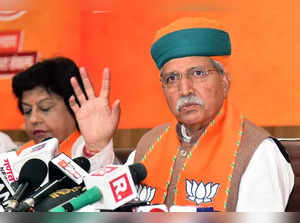 IANS
IANSNew Delhi: Addressing the issues of vacancies in the higher judiciary and pending cases, and finalising the Memorandum of Procedure (MoP) are the key challenges before Arjun Ram Meghwal who was allocated the law portfolio on Monday. The MoP is a set of documents which guide the appointment, elevation and transfer of high court and Supreme Court judges.
Meghwal was appointed as minister of state for law and justice with independent charge in May last year when he replaced Kiren Rijiju.
After the Modi 3.0 government was sworn in on Sunday, Meghwal was appointed as a minister of state with independent charge.
On Monday, he was allocated the law portfolio, an area he is already aware of.
According to data shared by the government with Parliament, over five crore cases are pending across courts -- the lower courts, the 25 high courts and the Supreme Court.

There are various reasons for the rising pendency but one of key reasons is vacancies in the judiciary.
As on June 1, while there are two vacancies in the top court, posts of 345 judges are vacant in the high courts.
While the sanctioned strength of the apex court is 34, the 25 high courts have a combined sanctioned strength of 1,114.
Another key issue will have to handle is the finalisation of the MoP.
Seeking to replace the Collegium system of appointments of judges of the Supreme Court and the high courts with a more transparent appointment mechanism, the government had brought into operation the Constitution (99th Amendment) Act, 2014 and the National Judicial Appointments Commission Act, 2014 effective April 13, 2015. The new law was passed by Parliament with near unanimity.
However, both the Acts were challenged in the Supreme Court which in October, 2015 declared the Acts as unconstitutional and void.
The Collegium system as existing prior to the enforcement of the two Acts was declared to be operative.
The top court issued an order on supplementing the MoP saying that the government may finalise the document supplementing it in consultation with the chief justice of India.
It was laid down that the chief justice of India will take a decision based on the unanimous view of the Collegium comprising four senior-most judges.
Despite a series of back and forth between the government and the top court, the MoP's finalisation remains pending.
Meghwal was appointed as minister of state for law and justice with independent charge in May last year when he replaced Kiren Rijiju.
After the Modi 3.0 government was sworn in on Sunday, Meghwal was appointed as a minister of state with independent charge.
On Monday, he was allocated the law portfolio, an area he is already aware of.
According to data shared by the government with Parliament, over five crore cases are pending across courts -- the lower courts, the 25 high courts and the Supreme Court.
Modi Cabinet 3.0: Who gets what | Check the complete list

rime Minister Narendra Modi has retained 34 ministers from his previous council, including 19 with Cabinet berths, as he begins his third term. Prominent names include Rajnath Singh, Amit Shah, Nitin Gadkari, Nirmala Sitharaman, and S Jaishankar who have retained their previous portfolios.
There are various reasons for the rising pendency but one of key reasons is vacancies in the judiciary.
As on June 1, while there are two vacancies in the top court, posts of 345 judges are vacant in the high courts.
While the sanctioned strength of the apex court is 34, the 25 high courts have a combined sanctioned strength of 1,114.
Another key issue will have to handle is the finalisation of the MoP.
Seeking to replace the Collegium system of appointments of judges of the Supreme Court and the high courts with a more transparent appointment mechanism, the government had brought into operation the Constitution (99th Amendment) Act, 2014 and the National Judicial Appointments Commission Act, 2014 effective April 13, 2015. The new law was passed by Parliament with near unanimity.
However, both the Acts were challenged in the Supreme Court which in October, 2015 declared the Acts as unconstitutional and void.
The Collegium system as existing prior to the enforcement of the two Acts was declared to be operative.
The top court issued an order on supplementing the MoP saying that the government may finalise the document supplementing it in consultation with the chief justice of India.
It was laid down that the chief justice of India will take a decision based on the unanimous view of the Collegium comprising four senior-most judges.
Despite a series of back and forth between the government and the top court, the MoP's finalisation remains pending.
( Originally published on Jun 10, 2024 )
(Catch all the Business News, Breaking News, Budget 2024 Events and Latest News Updates on The Economic Times.)
Subscribe to The Economic Times Prime and read the ET ePaper online.
Read More News on
(Catch all the Business News, Breaking News, Budget 2024 Events and Latest News Updates on The Economic Times.)
Subscribe to The Economic Times Prime and read the ET ePaper online.





